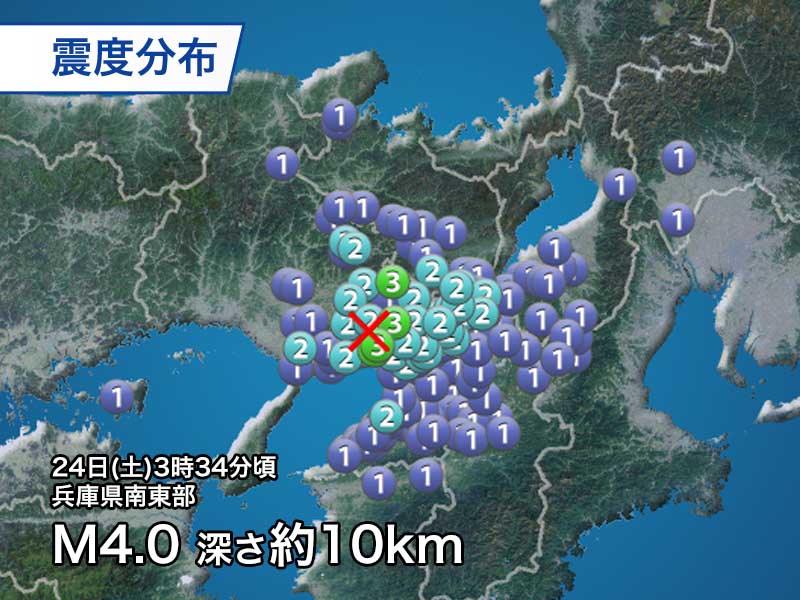09/25/2022 10:16 Weather news
There are many earthquakes from the Kanto region to the Pacific Ocean side of Tohoku, and earthquakes occur in inland areas in western Japan as well. There were six earthquakes with a seismic intensity equal to or greater than 3. (from 19 September to 25 September at 10:00)
–
Japan: numerous faults in southern Hyogo prefecture

This is the first time since March of this year that an earthquake of a seismic intensity of 3 or greater has occurred in the southeastern part of Hyogo prefecture, but it has been 11 years since 2011 that an earthquake like this has occurred. near Osaka Bay. The earthquake mechanism is analyzed as a strike-slip type.
The epicenter of this earthquake was near the aftershock area of the 1995 Great Hanshin-Awaji Earthquake (Southern Hyogo Prefecture earthquake). The south side of the Rokko Mountains is a fault zone with many faults, so activity is believed to have occurred in that area.
The Headquarters for Promoting Earthquake Research estimates that the probability of a magnitude 7.9 earthquake occurring in the Rokko-Awajishima fault zone within the next 30 years is about 0% – 1%. More than 25 years have passed since the earthquake, so please pay attention again to the surrounding seismic activity.
– This earthquake was caused by the Suwanosejima volcanic activity. According to the Japanese Meteorological Observatory, around 11:50 am on the 24th (Saturday), there was a temporary increase in volcanic earthquakes with epicenters near the western side of Suwanose Island. Among them, a large earthquake with a maximum seismic intensity of 2 was a felt earthquake. No particular changes were observed in the volcanic plume of the Suwanosejima / Mitake crater. Suwanosejima continues to have many eruptions, so caution is needed. – In addition, around 4:34 pm, an earthquake with a magnitude of 3.8 and a depth of about 50 km occurred with its epicenter in the southern part of Ibaraki prefecture. At 5:39 pm, an earthquake of magnitude 3.9 and a depth of approximately 40 km occurred with an epicenter in Ibaraki prefecture and a seismic intensity of 2 was observed in the city of Hitachi and the city of Takahagi, in the Ibaraki prefecture. Both occurred in areas with many earthquakes and it is thought that it was a coincidence that they occurred one after the other on the 3rd (Saturday). – Most earthquakes are concentrated at a depth of about 10 km even in the depth of the east-west section. There are few events at depths of 20km or more, but there are some at depths of 100km or more. Earthquakes that occur near the boundary between the Pacific Plate and the Eurasian Plate or within the Pacific Plate. Most of the deep earthquakes are of magnitude 4, but in May 2014 there was a large earthquake of magnitude 6.0. In this earthquake, a maximum seismic intensity of less than 5 was observed in Chiyoda Ward, Tokyo, and a seismic intensity of 3 to 4 was observed over a large area of the Kanto region, causing damage such as injuries. – On the 20th (Tuesday) of Japan, an earthquake with a magnitude of 7.6 and a depth of about 15 km occurred with its epicenter on the Pacific side of Mexico. The seismic mechanism is analyzed as a type of reverse fault with a pressure axis in the north-northeast-south-southwest direction. Since the epicenter was close to the sea and the scale of the earthquake was large, a tsunami was generated and the highest point was 79 cm. Strong tremors caused damage to buildings near the epicenter and local authorities announced that some people died. In addition, two days later, on the 22nd (Thursday), an earthquake with a magnitude of 6.8 occurred with its epicenter a little to the east. It appears to be a series of activities or aftershocks. The Pacific Ocean side of Mexico is the boundary between the Cocos Plate and the Caribbean Plate and is an area where large earthquakes frequently occur. In 1995, an 8.0 magnitude earthquake occurred near the epicenter of this earthquake. Also, in 1985, the same local time as this time, an 8.0 magnitude earthquake occurred on September 19 and became a hot topic. – The earthquake mechanism is analyzed as a strike-slip type. The aftershocks followed one after another, and a 5.5-magnitude earthquake occurred about an hour after the first. There are concerns about damage from severe tremors around the epicenter. – * Information on earthquake sources and seismic intensity in Japan comes from the Japanese Meteorological Agency, unless otherwise specified. Information about the overseas epicenter comes from the United States Geological Survey (USGS), unless otherwise noted. There may be differences in the hypocenter information depending on the publishing organization. – –
–
Japan: Suwanosejima volcanic earthquake with seismic intensity of 2

–
Japan: A series of earthquakes occurred in the Kanto region on the 3rd (Saturday)

–
There have been earthquakes as large as M6.0 in the past.

–
World: 7.6 magnitude earthquake in Mexico

–
A 6.5 magnitude earthquake hits southern Taiwan

–

Reference materials, etc.


